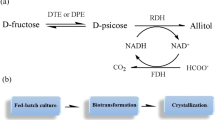Abstract
Objective
To produce tagatose from fructose with a high conversion rate and to establish a high-yield purification method of tagatose from the reaction mixture.
Results
Fructose at 1 M (180 g l−1) was converted to 0.8 M (144 g l−1) tagatose by a three-step enzymatic cascade reaction, involving hexokinase, plus ATP, fructose-1,6-biphosphate aldolase, phytase, over 16 h with a productivity of 9 g l−1 h−1. No byproducts were detected. Tagatose was recrystallized from ethanol to a purity of 99.9% and a yield of 96.3%. Overall, tagatose at 99.9% purity was obtained from fructose with a yield of 77%.
Conclusion
This is the first biotechnological production of tagatose from fructose and the first application of solvent recrystallization for the purification of rare sugars.



Similar content being viewed by others
References
Adachi S, Sugawara H (1963) Separation of ketose and aldose by chromatography on an ion-exchange column. Arch Biochem Biophys 100:468–471
Amhudkar SV, Anantharamg V, Maloneyan PC (1990) UhpT, the sugar phosphate antiporter of Escherichia coli, functions as a monomer. J Biol Chem 265:12287–12292
Chen YR, Larimer FW, Serpersu EH, Hartman FC (1999) Identification of a catalytic aspartyl residue of D-ribulose 5-phosphate 3-epimerase by site-directed mutagenesis. J Biol Chem 274:2132–2136
Creuzenet C, Belanger M, Wakarchuk WW, Lam JS (2000) Expression, purification, and biochemical characterization of WbpP, a new UDP-GlcNAc C4 epimerase from Pseudomonas aeruginosa serotype O6. J Biol Chem 275:19060–19067
Hong YH, Lee DW, Lee SJ, Choe EA, Kim SB, Lee YH, Cheigh CI, Pyun YR (2007) Production of D-tagatose at high temperatures using immobilized Escherichia coli cells expressing L-arabinose isomerase from Thermotoga neapolitana. Biotechnol Lett 29:569–574
Itoh H, Okaya H, Khan A, Tajima S, Hayakawa S, Izumori K (1994) Purification and characterization of D-tagatose 3-epimerase from Pseudomonas sp. ST-24. Biosci Biotechnol Biochem 58:2168–2171
Izumori K (2006) Izumoring: a strategy for bioproduction of all hexoses. J Biotechnol 124:717–722
Jagtap SS, Singh R, Kang YC, Zhao H, Lee JK (2014) Cloning and characterization of a galactitol 2-dehydrogenase from Rhizobium legumenosarum and its application in D-tagatose production. Enzyme Microb Technol 58–59:44–51
Kim BC, Lee YH, Lee HS, Lee DW, Choe EA, Pyun YR (2002) Cloning, expression and characterization of L-arabinose isomerase from Thermotoga neapolitana: bioconversion of D-galactose to D-tagatose using the enzyme. FEMS Microbiol Lett 212:121–126
Kim HJ, Ryu SA, Kim P, Oh DK (2003) A feasible enzymatic process for D-tagatose production by an immobilized thermostable L-arabinose isomerase in a packed-bed bioreactor. Biotechnol Prog 19:400–404
Kim HJ, Hyun EK, Kim YS, Lee YJ, Oh DK (2006) Characterization of an Agrobacterium tumefaciens D-psicose 3-epimerase that converts d-fructose to D-psicose. Appl Environ Microbiol 72:981–985
Lee DW, Jang HJ, Choe EA, Kim BC, Lee SJ, Kim SB, Hong YH, Pyun YR (2004) Characterization of a thermostable L-arabinose (D-galactose) isomerase from the hyperthermophilic eubacterium Thermotoga maritima. Appl Environ Microbiol 70:1397–1404
Lim BC, Kim HJ, Oh DK (2007) High production of D-tagatose by the addition of boric acid. Biotechnol Prog 23:824–828
Murkin AS, Chou WK, Wakarchuk WW, Tanner ME (2004) Identification and mechanism of a bacterial hydrolyzing UDP-N-acetylglucosamine 2-epimerase. Biochemistry 43:14290–14298
Rollini M, Manzoni M (2005) Bioconversion of D-galactitol to tagatose and dehydrogenase activity induction in Gluconobacter oxydans. Proc Biochem 40:437–444
Samuel J, Luo Y, Morgan PM, Strynadka NCJ, Tanner ME (2001) Catalysis and binding in L-ribulose-5-phosphate 4-epimerase: a comparison with L-fuculose-1-phosphate aldolase. Biochemistry 40:14772–14780
Taguchi H, Senoura T, Hamada S, Matsui H, Kobayashi Y, Watanabe J, Wasaki J, Ito S (2008) Cloning and sequencing of the gene for cellobiose 2-epimerase from a ruminal strain of Eubacterium cellulosolvens. FEMS Microbiol Lett 287:34–40
Thomason LC, Costantino N, Court DL (2007) E. coli genome manipulation by P1 transduction. Curr Protoc Mol Biol Chapter 1:Unit 1.17
Uechi K, Takata G, Fukai Y, Yoshihara A, Morimoto K (2013) Gene cloning and characterization of L-ribulose 3-epimerase from Mesorhizobium loti and its application to rare sugar production. Biosci Biotechnol Biochem 77:511–515
Acknowledgements
This study was supported by the Ministry of Trade, Industry & Energy (MOTIE), Korea Institute for Advancement of Technology (KIAT) through the Encouragement Program for The Industries of Economic Cooperation Region.
Supporting information
Supplementary Fig. 1—Bio-LC profiles of (I) substrate and (II) product in the conversion of F6P to T6P by FbaA.
Supplementary Fig. 2—Effects of the pH and temperature of FbaA on the 4-epimerization of F6P to T6P by FbaA.
Supplementary Fig. 3—Metabolic pathway engineering for the overproduction of tagatose from glucose or fructose and glycerol in E. coli.
Supplementary Fig. 4—Purification of tagatose from the reaction mixture with fructose by ion chromatography using a column containing Amberite CR 1310 (Ca2+ form) resin.
Supplementary Fig. 5—HPLC profiles during the separation of tagatose from the reaction mixture with fructose by recrystallization from ethanol.
Author information
Authors and Affiliations
Corresponding author
Electronic supplementary material
Below is the link to the electronic supplementary material.
Rights and permissions
About this article
Cite this article
Lee, SH., Hong, SH., Kim, KR. et al. High-yield production of pure tagatose from fructose by a three-step enzymatic cascade reaction. Biotechnol Lett 39, 1141–1148 (2017). https://doi.org/10.1007/s10529-017-2340-3
Received:
Accepted:
Published:
Issue Date:
DOI: https://doi.org/10.1007/s10529-017-2340-3



